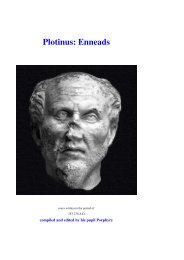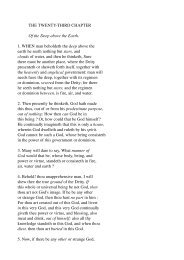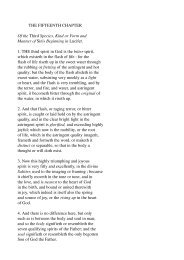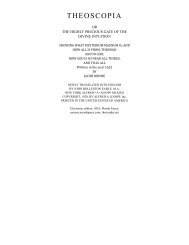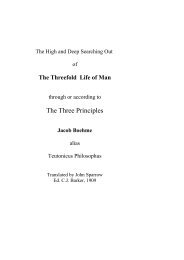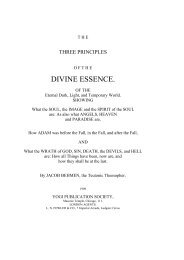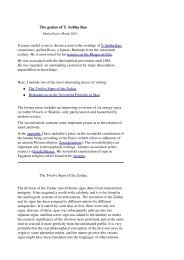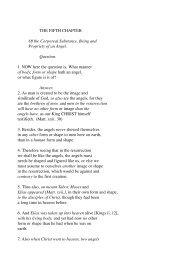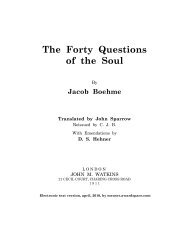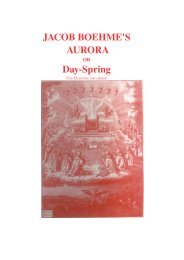Gerald Massey's Lectures - Society in evolution - Awardspace
Gerald Massey's Lectures - Society in evolution - Awardspace
Gerald Massey's Lectures - Society in evolution - Awardspace
You also want an ePaper? Increase the reach of your titles
YUMPU automatically turns print PDFs into web optimized ePapers that Google loves.
put to death and they come to life aga<strong>in</strong>," and the reason of this is that "God the Invisible<br />
hath himself from Heaven planted the truth and the holy <strong>in</strong>comprehensible Word and<br />
established him <strong>in</strong> their hearts." This epistle of James is <strong>in</strong>def<strong>in</strong>itely older than the<br />
Canonical history. James is believed to have died about the year 60 of our era, and <strong>in</strong> this,<br />
one of the earliest utterances of the Church, <strong>in</strong>stead of the History, we f<strong>in</strong>d the div<strong>in</strong>e<br />
Makheru of the Egyptian mythos <strong>in</strong> a mystical and doctr<strong>in</strong>al phase.<br />
Instead of an orig<strong>in</strong>al gospel based on the life, character, and teach<strong>in</strong>gs of his own human<br />
brother, James presents us with the translated Word-of-truth--the Horus of Egypt, and the<br />
Christ of the Gnostics, who could not become historical. This beg<strong>in</strong>n<strong>in</strong>g, then, is<br />
doctr<strong>in</strong>al, and the doctr<strong>in</strong>e, like the portrait, is Egyptian. The same mythos was visibly<br />
cont<strong>in</strong>ued <strong>in</strong> the Gnostic phase. In the Gospels, which were be<strong>in</strong>g compiled at least one<br />
hundred years later, we f<strong>in</strong>d this same Word of Truth, which was personated by Horus-<br />
Makheru and by Iu-em-hept <strong>in</strong> Egypt some 3,000 years earlier, is now represented <strong>in</strong> a<br />
personal character as Jesus the Christ.<br />
This Word of Truth, which is doctr<strong>in</strong>al and non-historical, accord<strong>in</strong>g to James, is the<br />
Word of Truth made flesh accord<strong>in</strong>g to John. Also, the Christ is the Horus cont<strong>in</strong>ued <strong>in</strong><br />
his two characters. Hence the Word, or Spirit of Truth, which proceedeth from the Father,<br />
is to come as the mystic Paraclete who shall testify to the reality of an historic Jesus.<br />
These two characters, as the Sayer and Doer, constitute the double foundation of the<br />
Christ <strong>in</strong> the other Gospels. The Christ of Matthew is chiefly the Sayer. The Christ of<br />
Luke is ma<strong>in</strong>ly the Doer. He is mighty <strong>in</strong> deed and word! He is the Healer or Doer with<br />
the Word. "What a Word is this"! exclaim the multitude, who are amazed at the miracles.<br />
Both characters had been blended <strong>in</strong> one as Horus-Makheru, the Word of Truth, who was<br />
mythical <strong>in</strong> Egypt, and who is mythical <strong>in</strong> the teach<strong>in</strong>g of James before the Word was<br />
described as be<strong>in</strong>g made flesh, to become an historical personage <strong>in</strong> the later Gospel<br />
accord<strong>in</strong>g to John. This is the fatal k<strong>in</strong>d of fact that turns the canonical history <strong>in</strong>to<br />
fiction, and brands the falsifiers full <strong>in</strong> the face. There is no room left here for any<br />
historic fulfilment, and no need of any personal Savior or vicarious victim. The Word of<br />
Truth is the Spirit of God, the Begetter of Souls, the Christ with<strong>in</strong>, the Br<strong>in</strong>ger of<br />
Immortality to Man, as it is <strong>in</strong> the teach<strong>in</strong>g of Hermes, of Zarathustra, of Philo, and of<br />
Paul, as well as James; as it was <strong>in</strong> Egypt, <strong>in</strong> Chaldea, <strong>in</strong> India, <strong>in</strong> all the Mysteries, no<br />
matter where the Gnosis or Kabalah may be found. In presence of the Gnosis, here as<br />
elsewhere, there is no place, no significance, <strong>in</strong> the alleged facts of a human history, lived<br />
for us by a carnalised Christ. And yet such a history was made out, and we are now able<br />
to get a glimpse of the forgers engaged <strong>in</strong> the process of mak<strong>in</strong>g it out!<br />
Our Canonical Gospels are a Palimpsest, with one writ<strong>in</strong>g so elaborated over another that<br />
the first is almost crossed out, and the rest are thoroughly confused. Yet, the whole of<br />
them have to be seen through before the matter can be really read. By hold<strong>in</strong>g this<br />
Palimpsest up to the light, and look<strong>in</strong>g at it long and closely, we can trace the large<br />
outl<strong>in</strong>e, the water-mark, of the Egyptian mythos, with its virg<strong>in</strong>-mother, who was Hathor-<br />
Meri--the Madonna--its child-Christ of 12 years, and the virile adult of 30 years, who was<br />
Horus, the ano<strong>in</strong>ted son of that Father <strong>in</strong> heaven whom he came to reveal. This is the<br />
earliest and most fundamental of the nuclei. Next we f<strong>in</strong>d a collection of Say<strong>in</strong>gs as the<br />
nucleus of the Gospel of Matthew. These say<strong>in</strong>gs were attributed to the Lord, and that<br />
Lord is supposed to have been a Judean peasant, as the orig<strong>in</strong>al author! It is noticeable,<br />
though, that the title of the Lord is not once applied to Jesus by Matthew <strong>in</strong> the earth-life,<br />
but after the resurrection he is called the "Lord." Now, it is well known to scholars that<br />
the Gospel accord<strong>in</strong>g to Luke is based upon, or concocted, with suitable alterations, from<br />
an earlier "Gospel of the Lord." That is, the latest gospel accord<strong>in</strong>g to the Gnostics,<br />
preceded the earliest of those that were made canonical. This was called the "Gospel of<br />
the Lord"--the kurios--and it is commonly referred to as the gospel of Marcion, the great<br />
Gnostic. But the Lord, as known to the Gnostics, was not a character that could become



